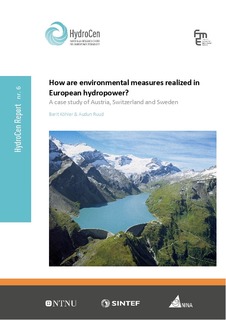How are environmental measures realized in European hydropower? - A case‐study of Austria, Sweden and Switzerland
Research report
Permanent lenke
http://hdl.handle.net/11250/2603532Utgivelsesdato
2019Metadata
Vis full innførselSamlinger
Sammendrag
This report explores how environmental measures are realized in European hydropower production, how they are financed, and how trade‐offs between hydropower production, environmental restoration and value creation are considered. How do other European countries deal with the challenges that the conflicting objectives of (increased) production of renewable energy on one hand, and of improving environmental conditions of the regulated watercourses on the other hand, pose? We are seeking more knowledge of how “greener” solutions are implemented in other European countries, and if such efforts can be a valid reference for Norwegian hydropower producers and exporters. In this study we map the current situation related to hydropower production, environmental status of the regulated water bodies and implemented measures, management practices, methods to assess trade‐offs and funding mechanisms in three European countries that are amongst the larger producers of hydropower in Europe in terms of installed capacity ‐ Austria, Switzerland and Sweden. We used desk‐top document studies and conducted structured interviews in the respective countries during spring/summer 2018. As the report clearly shows, the challenge and need to balance the complex nexus of trade‐offs between energy services and environmental objectives is quite similar in the analysed case countries. All three countries have made legal revisions and set new environmental goals. There exist now legal references enabling the enforcement to realize environmental mitigating measures, but the types of mitigation measures and their actual implementation varies. In all countries, efforts by single hydropower companies and NGOs were documented, with support of local, regional and national administrations, to implement environmental mitigation measures on a voluntary basis. Market‐based, private funding solutions such as support schemes of the eco‐labels Naturemade star (origin: Switzerland) and Bra Miljöval (origin: Sweden) play a role, but also EU public funding sources such as the EU LIFE‐program contribute to such endeavours (e.g. in Austria). Private, voluntary schemes such as the Bra Miljöval and Naturemade Star eco‐labels provide additional funding for environmental measures by addressing the environmentally conscious customers willing to pay an additional fee for “greener” hydropower. Such eco‐labels appear to be win‐win solutions for hydropower companies that are also concerned with reputation management as an integral part of a more diversified European energy market.
